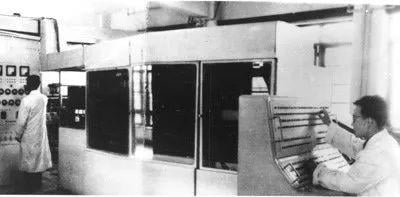Pioneers
4. Hardware
4.1. Xia Peisu

Figure 1: Xia Peisu
Source: Emmanuel Lafont (McNeill, 2020)
Downloadable teaching resource
Overview
Xia Peisu (1923–2014) was a pioneering Chinese computer scientist and educator who played a foundational role in establishing modern computing in China. Often referred to as the “mother of computer science in China,” she led the design of the country’s first fully indigenous general-purpose computer, 'Machine 107', while also shaping the educational systems that trained generations of Chinese computer scientists. Her contributions spanned both technical innovation and institutional development, laying the groundwork for national computing sovereignty during a period of post-war reconstruction and geopolitical isolation.
Background
Dr. Xia Peisu was born in Chongqing, China in 1923. After studying electrical engineering and telecommunications in China, she obtained a PhD in electrical engineering from the University of Edinburgh in 1950 (University of Edinburgh, 2024).
She returned to China during a time of geopolitical tension and post-war reconstruction. The Cold War and Sino-Soviet split deeply shaped the environment in which she would lead foundational efforts to build China’s first indigenous computing capacity (ICT CAS, 2014).
Contributions
Xia Peisu had a long and impactful career, shaping the future of computing in China through both research and education. She authored Principles of the Electronic Computer, the country’s first computer science textbook, laying the groundwork for formal instruction in the discipline. She also founded the Chinese Journal of Computers and the Journal of Computer Science and Technology, establishing national platforms for research and scholarly exchange (ICT CAS, 2014; University of Edinburgh, 2024).
Technically, her contributions were equally significant. Xia developed the “Maximum Time Difference Pipeline” theory and led key initiatives in Very Large-Scale Integrated (VLSI) circuit design and high-performance computing at the Institute of Computing Technology (ICT CAS, 2014). Most notably, she directed the development of Machine 107— completed in 1960— the first general-purpose computer fully designed and built in China (McNeill, 2020).
This project marked a turning point in China’s pursuit of technological independence. Yet her most enduring legacy lies in education: cultivating multiple cohorts of computer scientists, building institutions, and embedding computing expertise across the nation’s academic infrastructure McNeill (2020).
Feature: Machine 107: China’s First General-Purpose Computer
Machine 107, completed in 1960 under the leadership of Xia Peisu, was the first fully indigenously designed general-purpose electronic computer in China. Developed during the geopolitical strains of the Cold War and following the Sino–Soviet split, it marked a defining leap toward China's technological self-reliance and sparked a national computing revolution (ICT CAS, 2014; University of Edinburgh, 2024).

Figure 2: Model 107 computer at The Hong Kong University of Science and Technology (Wikimedia Commons, 2025)
Unlike earlier Soviet-supported prototypes such as Machine 103 and 104, Machine 107 was conceived and constructed entirely through domestic engineering ingenuity. Following the Sino–Soviet split, it became a cornerstone of China’s national computing agenda — catalysing a shift from dependency on foreign technology to indigenous research and academic infrastructure. Its deployment across Chinese universities signalled a new era of homegrown innovation and scientific confidence (McNeill, 2020).
Historical Significance
- Technological independence: Machine 107 was a landmark in China’s move away from reliance on Soviet hardware and expertise (ICT CAS, 2014).
- Educational milestone: Deployed across Chinese universities, it became the principal training system for early computing professionals (University of Edinburgh, 2024).
- Institutional legacy: Xia Peisu’s leadership helped catalyse the launch of China’s first computer science journals and academic departments, entrenching computing as a formal scientific discipline (McNeill, 2020).
While historic and modern computers may share a similar logic, fundamentally consisting of input, processing and output functions, modern computers are significantly smaller, more reliable and have become ubiquitous personal devices. You can learn more about computing, hardware and history on the OpenLearn course 'An introduction to computers and computer systems' (OpenLearn, 2021).
See also
The Xia-Peisu Award: Recognising women scientists in computing
References and further reading
Hu, C., Xu, J., Xu, Y., Qi, Y. and Su, L. (2024) Analyzing the Challenges and Possible Strategies for Female Researchers in China Based on the Number of Researchers and Social Phenomena. Available at: https://www.seresearch.qmul.ac.uk/content/pce/ediresources/files/Poster%20Nanchang%20students%202024.pdf (Accessed: 24 August 2025).
Institute of Computing Technology, Chinese Academy of Sciences (ICT CAS) (2014) Obituary of Academician XIA Peisu (1923–2014). Available at: http://english.ict.cas.cn/ns/es/201408/t20140830_127073.html (Accessed: 24 August 2025).
McNeill, L. (2020) The computer pioneer who built modern China. BBC Future. Available at: https://www.bbc.com/future/article/20200219-xia-peisu-the-computer-pioneer-who-built-modern-china (Accessed: 7 May 2025).
OpenLearn (2021) An introduction to computers and computer systems. Available at: https://www.open.edu/openlearn/digital-computing/an-introduction-computers-and-computer-systems/content-section-overview (Accessed: 24 August 2025).
University of Edinburgh (2024) Xia Peisu (1923–2014). Available at: https://information-services.ed.ac.uk/about/naming-spaces-after-inspirational-women/xia-peisu (Accessed: 24 August 2025).
Xia, P. (1950) I. On parametric oscillations in electronic circuits; and, II. A graphical analysis for non-linear systems. Edinburgh Research Archive. Available at: https://era.ed.ac.uk/handle/1842/34690 (Accessed: 24 August 2025).
Wikimedia Commons (2025) File:Model107 (1).jpg. Available at: https://commons.wikimedia.org/wiki/File:Model107_(1).jpg (Accessed: 24 August 2025)
